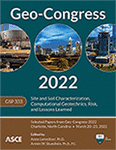Assessing Piping Risks by Finite Elements
Publication: Geo-Congress 2022
ABSTRACT
Backward erosion piping (BEP) is a leading cause of failure in dams and levees, but uncertainties in erosion progression characteristics and soil properties provide significant challenges to a deterministic analysis approach. For this reason, a risk-based approach to BEP failure is of great interest to engineers. The probability of failure is most commonly determined through the use of event trees and engineering judgment. When using this approach, geologic variability in the subsurface is incorporated into risk analysis through estimates of subjective probabilities regarding the existence of a continuous, erodible layer in the foundation. Recently, however, there have been developments in the random finite element method (RFEM) modeling of BEP progression that have demonstrated alternate means of assessing the probability of pipe progression in spatially variable soils. In this study, an RFEM model for BEP progression is presented. Results are presented to illustrate the influence of soil variability on the probability of BEP progression. Results indicate that the probability of BEP progression increases as the spatial correlation length increases.
Get full access to this article
View all available purchase options and get full access to this chapter.
REFERENCES
Bersan, S., Jommi, C., and Simonini, P. (2013). Applicability of the Fracture Flow Interface to the Analysis of Piping in Granular Material. In COMSOL Conference (pp. 1–8). Rotterdam, Netherlands.
Duncan, J. M. (2000). Factors of safety and reliability in geotechnical engineering”, J Geotech Geoenv, vol. 126, no. 4, pp. 307–316.
Fenton, G. A., and Griffiths, D. V. (1993). Statistics of flow through a simple bounded stochastic medium, Water Resources Res, vol.29, no.6, pp.1825–1830.
Fenton, G. A., and Griffiths, D. V. (2008). Risk Assessment in Geotechnical Engineering. John Wiley and Sons, Inc.
Fenton, G. A., and Vanmarcke, E. H. (1990). Simulation of random fields via local average subdivision, ASCE J Eng Mech, vol.16, no.8, pp.1733–1749.
Griffiths, D. V., and Fenton, G. A. (1993). Seepage beneath water retaining structures founded on spatially random soil, Géotechnique, vol.43, no.4, pp.5677–587.
Lee, I. K., White, W., and Ingles, O. G. (1983). Geotechnical Engineering, Pitman, London.
Robbins, B. A., and Griffiths, D. V. (2018). A simplified finite element implementation of the Sellmeijer model for backward erosion piping. In C. et Al. (Ed.), Numerical Methods in Geotechnical Engineering IX (pp. 1213–1218). Porto, Portugal: Taylor and Francis Group, London.
Robbins, B. A., and Griffiths, D. V. (2021). A two-dimensional, adaptive finite element approach for simulation of backward erosion piping. Computers and Geotechnics, 129, 103820. https://doi.org/10.1016/j.compgeo.2020.103820.
Robbins, B. A., Griffiths, D. V., and Fenton, G. A. (2021). Random finite element analysis of backward erosion piping. Computers and Geotechnics. (accepted).
Robbins, B. A., van Beek, V. M., López-Soto, J. F., Montalvo-Bartolomei, A. M., and Murphy, J. (2018). A novel laboratory test for backward erosion piping. International Journal of Physical Modelling in Geotechnics, 18(5), 266–279.
Schmertmann, J. H. (2000). The No-Filter Factor of Safety Against Piping Through Sands. In F. Silva and E. J. Kavazanijian (Eds.), Judgement and Innovation (pp. 65–133). American Society of Civil Engineers.
Sellmeijer, H., López, J., Cruz, D., van Beek, V. M., and Knoeff, H. (2011). Fine-tuning of the backward erosion piping model through small-scale, medium-scale and IJkdijk experiments. European Journal of Environmental and Civil Engineering, 15(8), 1139–1154. https://doi.org/10.3166/EJECE.15.1139-1154.
Sellmeijer, J. B. (2006). Numerical computation of seepage erosion below dams (piping). International Conference on Scour and Erosion.
USACE, & USBR. (2012). Internal Erosion Risks. In Best Practices in Risk Assessment for Dams and Levees (2012th ed.). Denver, CO.
Van Esch, J. M., Sellmeijer, J. B., and Stolle, D. (2013). Modeling transient groundwater flow and piping under dikes and dams. In 3rd International Symposium on Computational Geomechanics (ComGeo III) (p. 9).
Information & Authors
Information
Published In
History
Published online: Mar 17, 2022
Authors
Metrics & Citations
Metrics
Citations
Download citation
If you have the appropriate software installed, you can download article citation data to the citation manager of your choice. Simply select your manager software from the list below and click Download.
